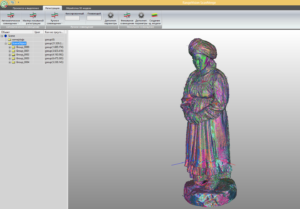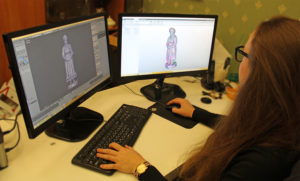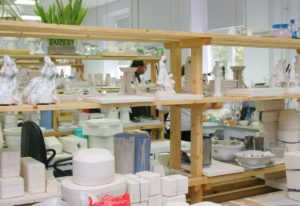 In Saint Petersburg, Russia, the history and culture of the country is preserved in delicate porcelain at the Museum of the Imperial Porcelain Factory. Maintained by the State Hermitage Museum, the permanent exhibition holds some of Russia’s rarest and most beautiful art – like the “Peoples of Russia” series, a set of porcelain figurines made by P.P. Kamensky between 1907 and 1917. The large collection features incredibly detailed and brilliantly colored representations of people from all walks of Russian life, in all manner of dress.
In Saint Petersburg, Russia, the history and culture of the country is preserved in delicate porcelain at the Museum of the Imperial Porcelain Factory. Maintained by the State Hermitage Museum, the permanent exhibition holds some of Russia’s rarest and most beautiful art – like the “Peoples of Russia” series, a set of porcelain figurines made by P.P. Kamensky between 1907 and 1917. The large collection features incredibly detailed and brilliantly colored representations of people from all walks of Russian life, in all manner of dress.
It’s really a stunning collection, and despite the fact that the sculptures are a century old, many of them look as though they could have been produced yesterday. Porcelain is a material that lasts – however, nothing lasts forever, and so the Imperial Porcelain Factory decided to preserve the collection in digital form. No matter how well something is crafted, some damage and wear is inevitable with time, which is why so many museums and historical institutions are turning to 3D scanning to preserve and reconstruct historical artifacts.
 The Imperial Porcelain Factory and the Hermitage Museum turned to the Cyberon Group, which specializes in 3D technology. Cyberon, armed with a RangeVision PRO 3D scanner, arrived at the museum to begin scanning the figurines, which range in height between 36 and 40 cm. There were several challenges to the project, according to Anna Ischenko, 3D Designer at Cyberon Group.
The Imperial Porcelain Factory and the Hermitage Museum turned to the Cyberon Group, which specializes in 3D technology. Cyberon, armed with a RangeVision PRO 3D scanner, arrived at the museum to begin scanning the figurines, which range in height between 36 and 40 cm. There were several challenges to the project, according to Anna Ischenko, 3D Designer at Cyberon Group.
“The figurines are more than 100 years old. Any tactile manipulation was avoided,” she explained. “The whole process was completed in the presence of museum workers, and any movement of the exhibits was carried out with their help and under their supervision…High precision scanning was required to make copies very close to the original. Because of this, the figurines had to be scanned in parts.”
 In addition, she continued, most of the figurines were painted in black or dark blue – shades that are notoriously difficult to scan. To make things even more complicated, porcelain has “its own peculiar gloss and shine,” Ischenko said, and as anyone who’s ever worked with a 3D scanner knows, the only thing worse than a dark-colored subject is a shiny dark-colored subject. Often technicians will coat shiny objects with a matte spray to make them easier to scan, but because of the age and value of the figurines, that wasn’t an option.
In addition, she continued, most of the figurines were painted in black or dark blue – shades that are notoriously difficult to scan. To make things even more complicated, porcelain has “its own peculiar gloss and shine,” Ischenko said, and as anyone who’s ever worked with a 3D scanner knows, the only thing worse than a dark-colored subject is a shiny dark-colored subject. Often technicians will coat shiny objects with a matte spray to make them easier to scan, but because of the age and value of the figurines, that wasn’t an option.
The RangeVision PRO was up to the challenges, however. The scanner has four scanning “zones” optimized for objects of different sizes; using the second scanning zone, the team placed each figurine on a turntable so that it could be captured from every angle without manipulating it more than necessary. Scans were taken from three different angles:
- 90º
- 45º from above
- 45º from below
 Additional lighting was needed to get a good image of the dark-colored objects, and multiple exposure settings were used to accommodate the light areas, such as hands, faces, and clothing details. Finally, the figurines were scanned lying down to obtain additional detail from the clothing.
Additional lighting was needed to get a good image of the dark-colored objects, and multiple exposure settings were used to accommodate the light areas, such as hands, faces, and clothing details. Finally, the figurines were scanned lying down to obtain additional detail from the clothing.
“Through the work we got 4-5 scan groups for light figurines and 10 for dark ones,” said Ischenko. “This is a convenient volume of data for post-processing.”
Once the scanning was complete, the scans were processed in RangeVision ScanCenter software, and the models were prepared for 3D printing in Blender. They were then printed in a gypsum polymer material, fired twice under high temperatures, and carefully painted by professional artists from the Imperial Porcelain Factory to perfectly match the originals.
A project like this one is daunting, but worth the effort. If the original figurines should ever be damaged, the museum now has not only physical copies but digital ones so that more can be made at any point in the future. Nothing is ever quite the same as an original piece of art, but 3D scanning and 3D printing can ensure that not even the tiniest detail is ever lost to time. Discuss in the Peoples of Russia forum at 3DPB.com.
[Photos provided by Imperial Porcelain Factory / Project completed by ABS3D.RU(JSC “Kiberon Group”)]
Subscribe to Our Email Newsletter
Stay up-to-date on all the latest news from the 3D printing industry and receive information and offers from third party vendors.
You May Also Like
3D Printing News Unpeeled: A $3000 SLS System, Construction Subsidies and Parameters
The Housing Affordability Crisis is one of Canadian President Trudeau’s biggest issues. Now the government has made subsidies available, including scaling new technologies, 3D printed housing and libraries of reapproved...
“Bundled Light” Enables High Quality Plastic 3D Printing from LEAM
Naturally, we expect current 3D printing methods to continuously improve, but it continues to do so in the most surprising ways. The latest development comes from LEAM, a startup spun...
Each to Their Own: Exploring Creality’s Latest Ender Trio as the Company Strengthens Its Commitment to 3D Printing Advocacy
Creality has reaffirmed its commitment to promoting 3D printing. The launch of the Ender-3 V3 SE, Ender-3 V3 KE, and Ender-3 V3 showcases the company’s dedication to catering to diverse...
3D Printing News Briefs, March 23, 2024: AM in the US Coast Guard, Navy, & More
In today’s 3D Printing News Briefs, we’re discussing the use of 3D printing in various branches of the military, including the U.S. Coast Guard, the U.S. Navy, and the German...





































